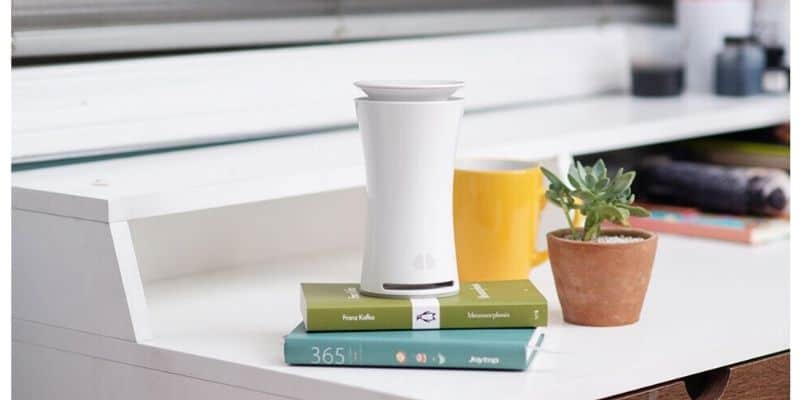As an Amazon affiliate, I earn from qualifying purchases.
In this article, I’ll show you how to use Alexa to monitor the air quality in your home. We’ll look at nine key metrics so you can assess the overall health of the air you and members of your family breathe each and every day.
Can I Use Alexa to Monitor Indoor Air Quality?
Yew-hoo…Yeah, you.
Are you looking for a way to maintain the most optimal indoor air quality in the smartest way possible?
Did you know you can now do it with everyone’s favorite AI speaker, Amazon Alexa?
You can.
Bad pun alert!
So, take a deep breath, sit back, and get ready for a breath of fresh air as I show you how to do just that 🌬️.
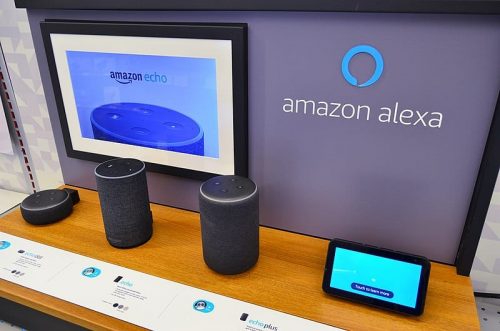
Image Credit: Wikipedia
What’s More Important Than the Air You Breathe?
When thinking about monitoring a smart home, most people usually think about smart home security cameras and maybe even smart locks.
Others may consider fire detection and suppression systems, and others may think about intricate home alarms.
One thing that is often an afterthought is monitoring the air we breathe indoors. There are surprisingly many activities that can affect the air we breathe in the place we consider our “safe haven.”
According to the CDC, the air we breathe indoors can be up to two to five times dirtier than the air outdoors.
Pretty crazy, right?
In this post, I’ll show you how to monitor the air quality in your smart home with Amazon Alexa.
So inhale, exhale and let’s take a closer look.
🌬️Check out the uHoo Air Quality Monitor at Amazon.
Common Causes of Poor Indoor Air Quality
You may be wondering what causes poor indoor air quality and how voice assistants like Amazon Alexa can help you keep your home safe and free from danger, but before I get too deep into that, let’s identify first what causes it.
Here are some key factors that can affect your home’s air quality.
Paints, Furniture, and Carpets
These seemingly innocent things inside your home can adversely affect the air you breathe. Paints, furniture, and carpets emit Volatile Organic Compounds or VOCs. These are chemical compounds that easily evaporate at room temperature. In the short-term, they can cause eye and throat irritation, headaches, difficulty breathing and more. Those who suffer from asthma or other respiratory illnesses are at especially high risk.
Cooking without Proper Ventilation
There’s nothing I like better than a good home-cooked meal, but when there’s poor air ventilation, it can be a problem. Cooking and other activities that involve the combustion of materials can produce what is known as PM2.5. These are air pollution particles smaller than 2.5 microns that can be inhaled into your lungs and cause health issues in the long-run. People with heart problems are at a high risk as these small pollution particles can become dislodged in the bloodstream.
Central Heating Systems, Water Heaters, Fireplaces, & Boilers:
These necessities for homeowners can sometimes also pose health and safety risks. When not properly maintained, they have the potential to cause Carbon Monoxide Poisoning.
Carbon Monoxide (CO) is a tasteless, colorless, and odorless gas that can cause dizziness, nausea, vomiting, chest pain, unconsciousness, and in some cases, even death. Every year, 50,000 people suffer from accidental CO poisoning. It is important that homeowners have an indoor air quality sensor that can quickly alert families of Carbon Monoxide buildup.
Common Household Cleaning Products
Most people don’t suspect cleaning products can be a source of indoor air pollution. It’s not surprising as these things are produced to “clean” our homes, right? Sadly, these cleaning products can actually pollute the air we breathe. For example, most disinfectant aerosols can increase PM2.5 levels inside your home. Others contain Phthalates which is considered an endocrine disruptor. These chemicals can change how hormones function in our bodies. They can increase your risks of asthma and lead to developmental issues in children.
📚 Related: Atomi Smart Portable Tower Space Heater Review
How Can Alexa Help Maintain Good Indoor Air Quality?
Amazon Alexa is a powerful smart home hub, and she has changed my home life for the better in many ways.
I use Alexa every day to do things like check the weather, control my lights, watch television, play music, order food, and much more.
But did you know that Alexa can also help you maintain healthy indoor air quality?
I was oblivious to this myself until recently when I had a uHoo approach me about the idea for this article. I was also pretty skeptical at first until I did some research and tested the product with Alexa.
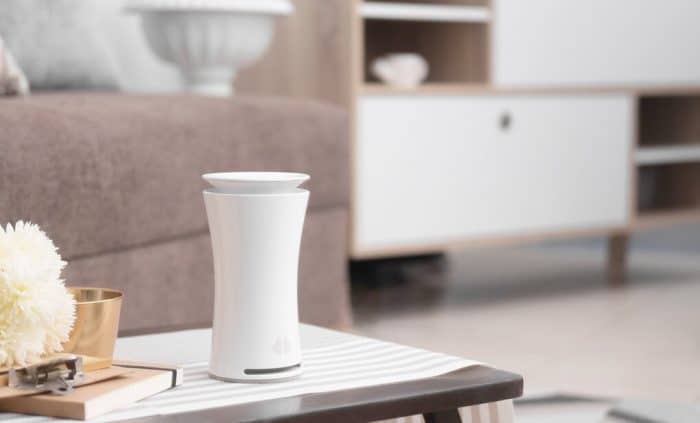
Image Credit: uHoo
Now, I’m kicking myself for not researching this sooner as I’m pretty blown away by the results.
AllThingsTech has a great video review that explains some of the benefits of uHoo in about seven minutes.
Dig the accent, man!
Pairing Alexa With a Smart Indoor Air Quality Sensor
Integrating Alexa with a smart indoor air quality sensor like uHoo can make the sensor even more useful and valuable in taking care of your family’s health.
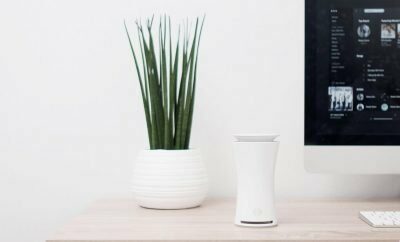
uHoo detects the following nine air quality attributes:
- Temperature
- Humidity
- Carbon Dioxide
- Total Volatile Organic Compounds
- Dust (PM2.5)
- Carbon Monoxide
- Ozone
- Nitrogen Dioxide
- Air Pressure
Aside from showing a real-time report on the app, uHoo also gives you useful tips on how to properly manage your indoor air quality. Furthermore, it can also be connected with other smart home devices inside your home through IFTTT.
Image Credit: uHooOnce uHoo is integrated with Alexa, it is super easy to monitor the air quality inside your home.
🌬️Check out the uHoo Air Quality Monitor at Amazon.
How to Connect uHoo to Alexa
Here are the basic steps to connect uHoo with Alexa:
- Download the uHoo app on Playstore or Apple store.
- Open your uHoo app settings.
- Tap Integrate and then, choose Alexa.
- Authorize uHoo to connect with Alexa.
After following these steps, you can now ask Alexa the following questions to get air-quality alerts without opening the app.
Alexa, ask uHoo to give me a summary for the living room.
Alexa, ask uHoo about the carbon dioxide summary in the bedroom.
Alexa, ask uHoo for humidity levels.
Once the report has been shared with you by Alexa, you can now take action on that specific air quality alert.
There are tons of articles online on how to improve the air quality for each of these key measures, so I won’t repeat any of that here. Instead, I’ll recommend a few ways that you could potentially use smart home technology to improve air quality when a problem is detected.
🌬️Check out the uHoo Air Quality Monitor at Amazon.
Using Smart Home Tech To Resolve Air Quality Problems
In addition to manually eliminating the causes of the poor air quality threats described above, there are some ways you can improve air quality if a threat is detected.
Ready for a shocker?
My preference is to take a smart home approach to a solution.
For example, if Alexa reported that your humidity levels are quite low, ask her to turn on your smart humidifier (WeMo). Another example is when your dust levels are too high, you can ask Alexa to turn on your smart vacuum (like iRobot) or robot mopper (like those I reviewed here) or to turn on your smart air purifier (BlueAir).
This can only be done if your Alexa is also connected with other smart home devices that can do these tricks.
Conclusion
Creating a healthier home is now possible with just a few taps and your voice.
By simply using your voice with Alexa and a monitor like uHoo, you have the power to keep your family away from the dangers of air pollutants.
Alexa, uHoo, and other smart home devices can help you keep air pollutants under control. Having these smart devices give us peace of mind that the air we are breathing is safe and healthy for our family. OK, time to exhale.
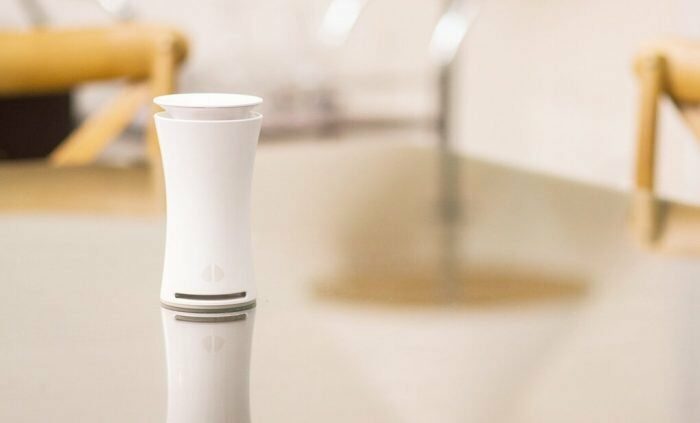
Image Credit: uHoo
Amazon Alexa as an Air Quality Monitor – Your Turn
So what do you think about these steps for how to use Alexa to monitor the air quality at home?
Are you interested in setting up a monitor like uHoo to help create a healthier indoor environment for you and your family?
Or do you just think all this is a lot of hot air?
Either way, I hope you will write to me using the comments box below and let me know.
In the meantime, I wish you a happy and healthy new year ahead!
You Might Also Enjoy
- Smart Nora vs Nitetronic Anti-snoring Pillows
- Best Smart Window Air Conditioners [That Even Work with Alexa]
- 11 Best Smart Space Heaters [3 Work with Alexa]
- How to Make Your Dumb AC Smart

Tim Brennan, a tech blogger and host of the @TecTimmy YouTube channel, writes about smart homes at oneSmartcrib, home theaters at UniversalRemoteReviews, and AI in writing at Writeinteractive. He holds a Journalism degree from Northeastern University and has covered technology for three decades. He lives on the ocean in Nahant, Massachusetts.
Please subscribe to my YouTube channel for a fun take on all things tech.

